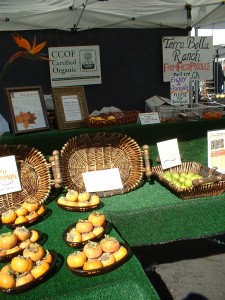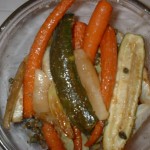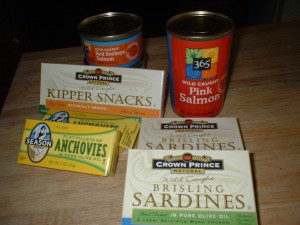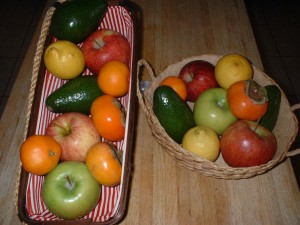By Catharine L. Kaufman (a.k.a. The Kitchen Shrink)
Edited by Dina Eliash Robinson
Every October, pink ribbons and shop window decorations herald its designation as Breast Cancer Awareness Month. Some people carry the reminder year-round—as did a hot hunk I recently noticed sporting a pink ribbon tattoo on his bulging bicep. He claimed it as a symbol of solidarity with his Mom who was battling the disease. Proliferation of pink-hued objects, unfortunately signals not only a growing membership in the breast cancer club, but the disease’s indiscriminate spread across ethnic, racial, age and economic groups. While Asian women are still more sparsely represented, and men hardly at all, this good news is offset by the ever-younger age of those being diagnosed.
We suspect pollution and the use of toxic chemicals in our foods to be the main culprits in the epidemic of all types of cancer, and worry that we have little or no control over our environment—no matter how conscientiously we recycle, save water, conserve energy and follow other green practices. But I’m here to tell you that this is not the time to throw in the towel or rely on a lucky roll of the dice by Fate.
Contrary to doomsayers, we do have some powerful self-protective weapons at our disposal and most of them consist of lifestyle choices we make—food selection and handling being the most effective. Ancient cultures relied on that for their health, even before old Hippocrates advised using food as medicine.
Being both the daughter of, and a survivor of breast cancer, I can say with the assurance of years of experience that a toxin-free, nutrition-rich diet can tip the balance in favor of good health. Other lifestyle choices—such as exercise, meditation, massage and/or chiropractic adjustments—also tend to strengthen the immune system, boost resistance and promote healing.
Years ago, when I traded a law practice for a career as a syndicated food columnist and healthy gourmet cooking teacher, little did I know that someday it would help me recover from, and stay free of breast cancer—as well as keep my family happy, healthy and well-fed.
So, while you arm yourself with tools provided by personal trainers, meditation gurus and other helpers, I’ll provide you with the edible components of your healthy lifestyle. I’ve put it in the form of an easy to follow primer of foods proven to be powerful factors in both cancer prevention and the expediting of post-treatment healing process. For optimum nutrition and protection from toxins, I highly recommend using organic products.
• Grapes—especially the red, purple and black varieties—come loaded with antioxidants called bioflavonoids that pack a powerful anti-cancer punch. Grape skin itself is a rich source of reservatrol, which blocks the production of certain enzymes known to stimulate the proliferation of cancer cells. The beneficial effects of these compounds might be gained by drinking small amounts of red wine. Although some studies warn that a daily intake of more than one glass of wine could actually increase the risk of breast cancer.
(* Note: Bioflavonoids—found in most fruits and vegetables that also contain Vit. C—are also known as Vitamin P, which when combined with Vit. C, help keep the thin walls of capillaries (small blood vessels) safe from tears and bleeding. This combo also has antioxidant, anti-viral & anti-inflammatory qualities; it curbs allergic histamine release and helps the body to absorb iron.)
• Cruciferous vegetables like broccoli, cauliflower, turnip greens, kale, Brussels sprouts, cabbage and the new super-nutritious BroccoSprouts contain indole-3-carbinol which has been found to fake out cancer cells by morphing estrogen into a more diluted, and thus harmless form.
• Carrots—Beta-Carotene Celebrities. Follow Bugs Bunny’s example and make beta-carotene-packed foods part of your diet to lower your breast cancer risk. Baby carrots—the tender, thin ones that still sport their leafy tops—contain the most easily absorbed form of this essential nutrient, which also keeps your eyesight sharp. Eat them raw as snacks or cut them into salads. But whatever you do, please don’t confuse them with the bagged or boxed impostor stumps falsely labeled “baby carrots,” which are mere machine-whittled parts of tough old carrots. Don’t be fooled into buying them just because they’re handy or might look cute in a stew. They tend to be too expensive for cooking anyway—it’s best to use mature and un-mutilated carrots for your hot dishes.
• Garlic by any other name—such as “Stinky Rose”—is just as fabulous a shield against viruses, bacteria, inflammation, hypertension (it’s a natural blood-thinner), breast cancer cells and even the occasional vampire. Raw garlic is loaded with allicin, a potent sulfur compound with immune boosting properties.
• Fabulous Fungi include some mushroom varieties known for their disease-fighting qualities. Shiitake, maitake and reishi, for example, contain polysaccharides that have been shown to boost the immune system, as well as lectin—a protein that is said to keep cancer cells in check.
• Seafoods Rich in Omega-3 Fatty Acids are under stress from over-fishing at this time, but it’s worth looking or waiting for supplies of wild-caught cold-water fish (no bottom-feeders, please) at your supermarket’s fishmonger. For optimum health benefits, nothing beats wild-caught salmon, sardines (with their Omega-3 and calcium-rich skin and bones intact, and preferably canned in pure olive oil!), herring (pickled in wine, not cream) and anchovies. Seaweed and other oceanic veggies are also treasure-troves of nutrients—such as beta-carotene, vitamin B-12 and the fatty acid chlorophylone, another defensive weapon against breast cancer.
• Seeds and Nuts are also Omega-3 powerhouses—and thus good substitutes for people who don’t care for fish. Flaxseed is known as an excellent Omega protector of healthy breasts, especially since it contains high levels of lignans and anti-inflammatory compounds. Same goes for nuts (go for almonds and walnuts) and seeds–especially pumpkin, sunflower and sesame seeds.
• Good Fats’ undisputed king is the smooth, delicious and heart-healthy olive oil, which is one of he main ingredients that keep breast cancer rates the lowest in the world among women following a Mediterranean diet. While grapeseed oil stands up better to high-heat cooking and baking than the more delicate olive oil, it is the latter that’s preferred by true gourmets in foods cooked at medium temperatures, as well as heatless on salads and as the dipping sauce for fresh bread, served in some Italian restaurants. Oils pressed from avocadoes, truffles and sesame seeds add not only exotic flavors to salads and other cold dishes, but many health benefits as well.
Canola oil is low in saturated fat, has a high proportion of monounsaturated fat and, since most of the toxic uric acid has been bred out of the rapeseed plant from which canola is derived, this oil is now considered a safe choice for cooking and baking by even the venerable Mayo Clinic. While butter is saturated fat and no stranger to cholesterol, an occasional small dollop on toast or in food adds nutrient and flavor in exchange for negligible or no harm.
A loud alarm clangs, however, when it comes to the trans-fat monsters that still lurk, alas, in most commercially produced baked goods, as well as in processed and fried foods—thanks to the FDA’s loophole-weakened ‘ban.’ So for prevention, health maintenance and the healing process, my advice to everyone is to stay clear of partially or fully hydrogenated vegetable oils, margarines and other trans-fats.
 • “Somewhere Over the Rainbow”—hummed under the breath or remembered from Oz—is an easy way to remind yourself to eat the colors of the rainbow. Red, yellow, green, purple and multicolored peppers, lycopene-rich tomatoes (even more effective when cooked), yams, squashes, spinach, blueberries, pomegranates, cherries and other fruits, berries and veggies contain powerful antioxidants that protect the body from harmful free radicals and toxins.
• “Somewhere Over the Rainbow”—hummed under the breath or remembered from Oz—is an easy way to remind yourself to eat the colors of the rainbow. Red, yellow, green, purple and multicolored peppers, lycopene-rich tomatoes (even more effective when cooked), yams, squashes, spinach, blueberries, pomegranates, cherries and other fruits, berries and veggies contain powerful antioxidants that protect the body from harmful free radicals and toxins.
• Sunshine Is An Indispensable Life-Source with bone-building and health-protective qualities that in recent years have been overshadowed by warnings about its danger as a cause of epidermal damage ranging from skin cancer to liver spots, freckles and wrinkles. The resulting panic has had people lather up with sun-screening lotions, block rays with special clothes, hats and even gloves, or forsake daylight altogether, venturing out only after sunset like some spectral ghosts.
Supplementation with Vitamin D—and more recently, with Vitamin D3—combined with moderate skin exposure to sunlight, has had limited success in reversing, to some degree, osteoporosis and other ailments caused by sun-deprived living. But it’s not enough.
So amp up your immune system with such Vitamin D-rich foods as organic eggs, wild-caught mackerel, salmon, sardines, herring, kippers, roe, cod liver oil (if you can stomach it), organic butter and D3-fortified breakfast cereal. Oh yes, don’t forget to walk, bike or do other weight-bearing exercises to bring your bones up to healthy strength.
• Tea, the Oldest New Health Drink. Had we paid attention to the Chinese, Indians and Brits, it wouldn’t have taken us this long to find out how healthy this versatile beverage is. Although green tea is now the rage, with white tea a recent snobby divergence and twig tea an ancient favorite, the once ubiquitous black tea is gaining popularity now that it’s strong bona fides as a health-booster have been rediscovered.
While all teas (except for certain so called ‘herbal’ or ‘fruit’ infusions) contain antioxidants, the justly praised green tea is a source of polyphenol antioxidant, known as a potent foe of certain cardiovascular and neurodegenerative diseases. Polyphenol antioxidant is also found in such phytonutrient-rich foods as legumes, apples, berries, grapes, cantaloupes, broccoli, cabbage, parsley and onions. When grown organically, these legumes, veggies and fruits are as well equipped to fight a variety of cancers as the highly regarded green and other teas. Especially the organic varieties, which taste better and are free of agricultural and customs-sprayed chemicals.
Black teas are preferred for their high octane caffeine kick; green, white and twig teas provide a gentle pick-me-up that still lets you rest at night; and chamomile, along with several other soporific herbal beverages, are better than any sleeping pill at bedtime. Decaf tea varieties offer good flavors, full antioxidant protection, but minus stimulation. A splash of almond milk adds body and a richer taste to most teas. A teaspoon of honey transforms them into throat-soothing balm, which can be enhanced with lemon for an extra Vitamin C protection.
• The Two Faces of Soy. Nothing is more versatile and adaptable to low-cholesterol nutrition than tofu, a most nutritious product derived from the humble soybean. Edamame makes a fine appetizer for any meal, though I bet hardly anyone around the table would associate this delicious celadon-green legume with soy. Another great soy impostor is the smoky, meat-like tempeh products in some grocery stores, which, in the hands of a creative cook, could fool the most rabid enemy of any food labeled ‘healthy.’
Of course, I can only vouch for all this being healthy and nutritious fare when made of organic soybeans, not with the genetically modified (GMO) ‘Frankenstein” version. What’s more, even organic soy products have become highly controversial when connected to the issue of estrogen-affected cancers. Advocates claim that the isoflavinoids contained in soy work as an estrogen decoy to block the body’s stronger estrogens that stimulate cancer cells. Opponents whose research indicates that soy’s phyto or plant estrogen may actually feed the growth of cancer cells, advise patients to eliminate this legume completely from their diet.
Unfortunately, this is easier said than done. Mainly because, as a government subsidized crop (along with wheat and corn), more soy is grown than the market can absorb. The glut then motivates commodities traders to find new, profitable uses for soybeans. You’ll notice that almost all bottled salad dressings, mayonnaise, breads, cereals and other packaged foods contain soy oil—one of the few fabrications that can actually make even organic soy unhealthy. Soy flour and other products derived from this legume also show up in various foods—some not even flagged on labels, thanks to faulty food-labeling regulations—making it impossible for a large and increasingly vulnerable segment of the population (especially breast cancer survivors) to protect their health.
Four pieces of advice: Buyer beware; keep track of new research on the soy-cancer connection; don’t let the quest for zero soy deprive you of essential nutrients; and use commonsense in balancing benefits versus risk.
• Herbs and Spices lend more than flavor to foods. Take the Mighty Parsley—touted by the American Institute of Cancer Research as effective in protecting cells from cancer, due to its rich store of Vitamin C, iron and flavonoids. Turmeric, the Indian spice that lends its color to curry, not only intensifies the flavors of cooked foods, but its active ingredient, curcumin, helps prevent the joint inflammation that makes rheumatoid arthritis so painful and, according to Rutgers University researchers, may slow the spread of prostate cancer. Cinnamon puts the brakes on leukemia cancer cells, lowers bad cholesterol and blood sugar, among other benefits. Rosemary, sage, basil, red paprika and countless other health-guardians are waiting on your spice rack to help you stay healthy.
• Gangbuster Cancer-Fighting Foods. Cruciferous vegetables like broccoli and cabbage pack a mighty punch against the big-C. First as a preventive shield, second as an aggressive warrior, and third as a healing agent that helps rebuild cells damaged by drugs and radiation.
Arm your immune system with the following recipe—made even a better protector when teamed up with grilled wild-caught salmon and followed by a leisurely stroll in the sunshine. Bon appetit.
Brocslaw
(Use organics if at all possible. They taste better and save on doctor bills)
1 16-ounce bag of shredded broccoli or two heads of fresh chopped broccoli
1/2 small red pepper, diced
1/2 small yellow pepper, diced
1/2 small red onion, diced
2 scallions, thinly sliced
2 carrots, grated
1/4 cup of slivered almonds
2 cloves fresh garlic
6 cherry tomatoes or 6 black olives—for garnish
Dressing
1 cup of mayonnaise made with olive oil
2 tablespoons of apple cider vinegar
1 tablespoon of sesame oil
2 tablespoons of brown sugar
Pinch of wasabi powder—or cancer-fighting cayenne pepper
Salt (optional) and cayenne pepper to taste
In a large bowl, combine the veggies. In a separate bowl, whisk the dressing ingredients. Toss with the slaw until evenly distributed. For decoration, top with the almond slivers and either the cherry tomatoes or olives—or both.
E-mail your questions and/or comments to me at [email protected], or to our blog editor at [email protected].
.
